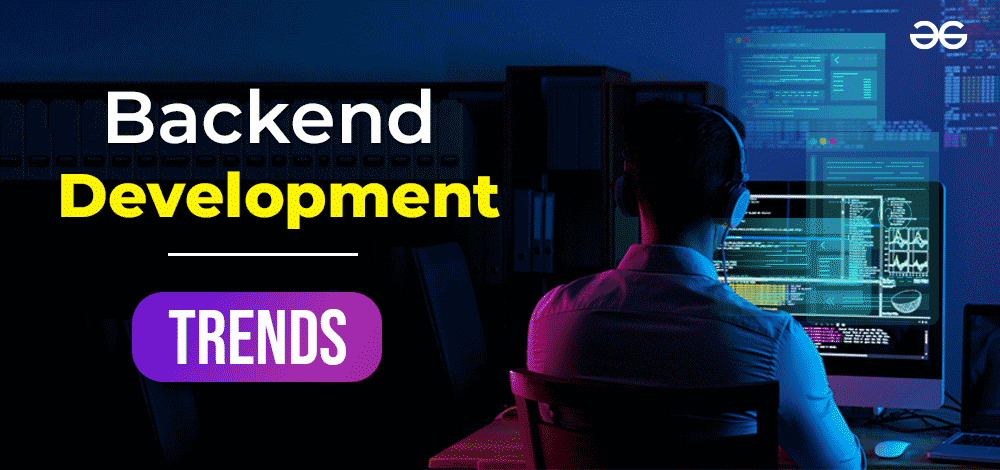The software development industry is expanding rapidly due to technological advancements. Backend development is the backbone of software development; it acts as a funnel between the front end and the database. Backend developers have endless options for developing, deploying, and managing server-side applications.
In this blog, we will discuss in detail about top 10 backend development trends. We will also discuss backend development, the roles, and responsibilities of backend developers, and the benefits of using backend frameworks. So let’s get started and explore these best backend development trends.
What is Backend Development?
Web development activities that are done on the backend of the application are called backend development. Backend development covers server-side development, application integration, and activities like creating libraries and writing APIs. It focuses on application architecture so it is really crucial to choose the right backend development technology. It functions as a process that sends and receives information to coordinate with the front end and display data.
Backend developers use tools like Oracle, MySQL, and SQL for reading, creating, updating, and deleting data which is then sent back to the front of the application.
To get more information about how to become a backend developer must refer to Backend Developer Roadmap.
Who is a Backend Developer?
So now you have got the information about backend development it’s time to understand who backend developers are, and their roles and responsibilities. A backend developer focuses on writing code that communicates between the website database and the user. As per the reports by the US Bureau of Labor and Statistics, this profession is expected to grow 13% by the year 2028, due to the increasing popularity of mobile devices and the e-commerce industry.
Some of the important skills that backend developers need to master are backend programming language, knowledge of backend frameworks, version control system, server handling, problem-solving, and communication skills. To get detailed information about the skills required to become a backend developer must refer to 10 Skills to Become a Backend Developer in 2024.
What are the Benefits of using Backend Frameworks?
The main objective of using Backend frameworks is to simplify the development process by using tools and libraries that can be used for web application development. Some of the advantages of using Backend frameworks are:
- Enhanced security: The use of backend frameworks provides enhanced security measures like encryption, data validation, and authentication.
- Faster development: The presence of the right frameworks ensure that developers can complete the tasks quickly. Also using these frameworks helps in automation that saves some time so developers can focus on complex tasks.
- Cost-effectiveness: Using backend development frameworks help to save time which reduces the development costs to a great extent.
- Scalability: Backend frameworks help developers to scale their applications quickly as per the business requirement.
Backend developers are currently in great demand but the demand for specific technologies, tools, frameworks, and languages shift with rapid change in technological advancements. In the next section, we will discuss in detail the best backend development trends in 2024.
Top Backend Development Trends to Follow
In the current technological landscape, several trending backend technologies are shaping the industry. Key among these are backend as a service (BaaS), serverless computing, Spring Boot, and Go. Let’s delve into these backend development trends to understand their impact and relevance in 2024.
1. Backend as Service( BaaS)
Backend as Service( BaaS) refers to a cloud-based model where technical teams outsource the backend services of an application to an external service provider. BaaS vendors provide services like pre-written software for activities that take place on the server side like database management, server authentication, push notification, and a lot more.
In the backend as a service model developers manage the backend using SDKs and APIs. This service helps in-house developers to focus more on writing code and maintaining the front end that fosters faster building of applications. Some of the popular BaaS service providers are AWS, Microsoft Azure, and Firebase.
2. Django
It is a high-level framework developed by Python that follows model-view-template architectural patterns. It helps you to keep the code logically organized into layers. Django handles controller aspects of the model, so you just need to take care of the specification of the data view and presentation templates. This framework provides some key features like code reusability, rapid development and takes minimal effort. Top companies that use Django are Spotify, Instagram, Prezi, Mozilla, Pinterest, Disqus, etc. Some of the key features of Django are:
- Enhanced security: Django provides enhanced security features, users can manage their passwords and accounts with its user authentication system.
- Rapid development: The use of Django fosters rapid development, generally project implementation takes a longer time but with Django, it happens quickly.
- Highly Scalable: Django provides enhanced scalability with an ability to switch easily from small to large-scale projects.
- Great community support: This framework has a large user base with a lot of talented individuals continuously working to improve the software.
3. Serverless Computing
It is a cloud computing model in which a cloud provider allocates resources on demand, further taking care of servers on behalf of customers. Since the application is cloud native so developers don’t have to worry about infrastructure management, server availability, or idle time. Some of the common examples of serverless computing are AWS Lambda, Google Cloud Functions, IBM OpenWhisk, and Microsoft Azure Functions.
Some advantages of Serverless computing are:
- Serverless architectures are highly scalable.
- It fosters quick deployments and updates.
- Developers are charged on a pay-as-you-go plan
- No server management is required
4. Laravel
Laravel is a free and open-source framework created by Taylor Otwell with the intention to foster web application development. Laravel has a simple and elegant syntax that adds amazing functionality to code. It is one of the top backend web development frameworks that is considered ideal for backend development by experts. It is used by some of the top companies like 9GAG, Crowdcube, PedidosYa, Ratio Razorpay, Pfizer, BBC, Lenovo, and a lot more. Some of the major advantages of using Laravel are:
- Great flexibility: It offers enhanced flexibility due to the presence of pre-installed libraries that have the ability to create and maintain advanced features.
- High performance: Laravel can handle requests much faster than most of the other frameworks. It has a unique queuing system that allows you to postpone certain website tasks which fosters high performance.
- Easy maintenance: Websites built on Laravel are easy to maintain and manage.
- Automated testing: This feature allows users to test application performance and ensures that the solution performs without any glitches.
5. Headless CMS
A headless content management system is a highly powerful and flexible way to manage content. It separates the content body from the presentation layer. This system provides flexibility to manage content and deliver it to the frontend environment. This makes it easier for developers to manage the tech stack. In this setup, the frontend and backend of the application are separated which makes it easier to mitigate targeted attacks. Some of the common examples of Headless CMS are Strapi, Netlify CMS, Sanity, and WordPress.
6. Spring Boot
Spring boot is an open-source Java-based framework that helps you create production-grade standalone applications. It helps developers to start rapidly without wasting time on configuration and preparation. Top companies that use Spring Boot are Google, Trivago, Accenture, Microsoft, Intuit, Amazon, Udemy, iFood, etc. Some of the major advantages of using Spring Boot are:
- Spring Boot is highly flexible and scalable.
- Using spring boot saves a lot of memory space.
- For using spring boot no XML configuration and WAR files are required.
- It can perform powerful batch processing and manage REST endpoints.
7. Static Site Generators
It is a tool that generates a full static HTML website based on raw data. It automates the task of coding HTML pages and gets those pages ready to serve. These HTML pages are pre-built so they load very quickly in users’ browsers. For backend developers, the major advantage is that the website doesn’t need server-side processes to run. Apart from this, the website built using static generators is highly customizable. Developers use a number of static generators using Hugo, Eleventy, Pelican, and Gatsby.
8. Elixir
Elixir is a programming language that has a simple syntax and is used for building and maintaining applications. It was created in 2011 and is currently one of the most loved programming languages as per Stack Overflow. It is used by some of the popular organizations like PepsiCo, Discord, and Mozilla.
9. Go
Go or GoLang is an Object-oriented programming language developed by Google in 2009. It is a general-purpose programming language that is used in a wide range of applications. Companies that use Go in their tech stacks are Uber, DropBox, Twitch, Alibaba, American Express, and Google.
Some of the key features of Go are:
- Provides Powerful performance
- Simplified code
- Designed for multi-core processors
- Fast garbage collection,
- Easy to learn and understand,
- Easy to maintain
- Provides enhanced scalability
10. Ruby on Rails
Ruby on Rails is a server-side web application development framework written in the Ruby programming language. It supports MVC architecture and uses software engineering paradigms like
- DRY( Don’t repeat yourself): It is a principle of software development that reduces the repetition of code.
- CoC( Convention over Configuration): It provides a lot of options for the best way to do things in web applications.
Some of the key features of Ruby on Rails are:
- Speedy software development: RoR is fast and it saves a lot of time by simplifying complex tasks, thus accomplishing goals faster. It enhances productivity and is easy to maintain.
- Safe and secure: It is highly safe and secure. Further, it supports both behavior-driven and test-driven development.
- Highly scalable: RoR scalability helps developers to handle bigger responsibilities. The project can be increased in magnitude easily without compromising the quality.
Conclusion
Backend developers are currently in great demand and top tech giants are paying exceptionally well to hire these professionals. Currently, there are so many backend development technologies so choosing the right one is really crucial. The right backend technology ensures enhanced scalability and provides instant response to customer requirements. So these are the top ten backend technologies and tools that are currently trending and will continue to trend in 2024. To grow your career in the backend development domain ensure to stay updated with all these backend development trends.
FAQs
What are the backend development trends for 2024?
The Latest Backend Developemnt trends are:
- Backend as Service( BaaS)
- Django
- Serverless Computing
- Laravel
- Headless CMS
- Spring Boot
- Static Site Generators
- Elixir
- Go
- Ruby on Rails
Which is the best backend framework in 2024?
The best backend framework for a backend developer are:
- Django
- Laravel
- Spring Boot
- Go
- Ruby on Rails
Should I learn backend in 2024?
Backend development involves creating and maintaining the server-side logic, databases, and APIs that power web applications and services. So learning Backend Developement is a valuable skills.
Which backend language is the fastest?
It depends upon the project requirement which language is the best and fastest but Overall Java is considered fastest Backend Programming Language.





